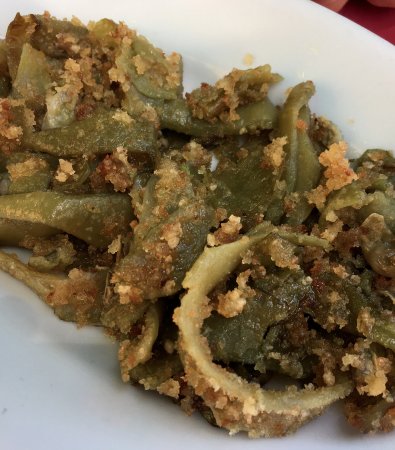Fava beans with breadcrumbs (Fave con la mollica)

Portions: Serves 6
Ingredients:
- 75 kg/4 lb fresh young fava beans
- 175 ml/6 fl oz water
- 5 tablespoons olive oil Salt Small bunch fresh mint leaves, finely chopped
- 125 g/4 oz stale white breadcrumbs
- 1 tablespoon white wine vinegar
- Freshly ground black pepper
Preparation:
Shell the beans, removing the skin from any big enough to have turned whitish. Cook with the water, 4 tablespoons oil, and a little salt, in a covered pot for about 10 minutes or until tender. Stir in the mint, breadcrumbs, vinegar, a little pepper, and 1 table- spoon of oil. Correct the salt. Serve cold. As soon as the skin of the fava bean begins to whiten and lose its intense green colour, it must be discarded. Skinning each bean individually is a very tedious business, just punishment for anyone wanting to serve large fava beans in elegant circumstances. One Saturday in May some years ago a few friends and I decided on the spur of the moment to drive out to our farm for the day. All we took with us was a loaf of fresh bread and a large wedge of primosale cheese. In the garden we picked young artichokes the narrow, pointed variety, silvery grey in colour and very sweet, which ripen here in the late spring and we boiled them in salted water. We also picked enormous fava beans, which we removed from their pods and put in a pan, covered with cold water, some salt, and a liberal dose of oregano. Just a few minutes after the beans reached the boiling point they began to swell and split their skins. We drained them, added some olive oil, and shot the tender innards mouth ward by pinching them between thumb and forefinger. The silverware remained in the drawer, our plates were heaped with fava skins and artichoke leaves, our fingers and chins were decidedly oily, but for what we lacked in chic we were more than repaid in pleasure. Squashes occupied several rows in the classical vegetable garden. Apicius’s aliter cucurbitas more Alexandrino, which is boiled squash in a spicy vinegar sauce, differs little from a modern Palermo recipe with a nicely misleading name.

